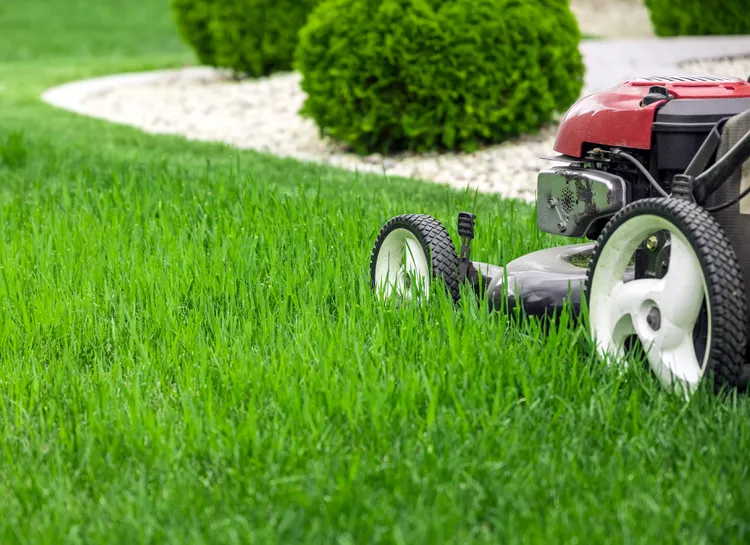9 Lawn Striping Patterns You Should Try Out
Last Updated on September 10, 2019 by Duncan
Lawn striping patterns not only give your lawn a fantastic look, but they also keep the grass healthier and easy to maintain. When you mow in the same direction all the time, the tire tracks start wearing out grass areas, causing ugly dead spots.
By switching up grass cutting patterns, you minimize wear and tear damage caused by the lawnmower tires. Alternating the mowing patterns also prevents the grass from getting compacted. This allows ample airflow keeping the grass healthy.
When cutting the different patterns, you have to mow the grass a little bit taller than usual, which contributes to better-looking lawn.
An added advantage is that the patterns help in hiding the weeds, giving the illusion that your lawn is perfect.
What do you need to stripe the lawn?
For you to apply the weight you need to bend grass and achieve the alternating light-dark effect, you need a lawn roller. This is a heavy, cylindrical garden tool made from metal or plastic.
You attach the lawn roller to the rear of the lawnmower. You can buy the tool online or from your local store. When making the purchase, ensure that the roller is compatible with your mower. Depending on the model you buy, you may have to fill the drum of the roller with water or sand before you attach it to the lawnmower.
Lawn striping patterns
There are plenty of lawn mowing patterns you can go with. The most common ones being:
Straight lawn stripes

Begin mowing from the perimeter around your property, then mow in opposing directions through the remaining areas. To prevent turf damage, be cautious when turning at the end of each row.
One of the most effective ways of preventing damage is making a simple “Y” turn at the end of each row.
Once you are done, consider going over the perimeter one more time to get rid of any stripe pattern irregularities that might be there giving you a clean, finished look.
Checkerboard stripe patterns

To achieve the patterns you need to begin mowing the perimeter around your property then mow in opposing directions through the remaining portion of the property. Again, take care that you don’t damage the turf when turning at the end of the rows.
Your next move should be to move perpendicular to the direction of the original mowing pattern. For example, if you were mowing in the north and south direction, now mow in the east and west direction.
The result is having one dark stripe running parallel to the lighter stripe. Repeat this until you have mowed the entire lawn, thereby creating alternating dark and lighter stripes. To remove any stripe pattern irregularities, go over the perimeter one more time.
Diagonal or criss-cross stripe patterns

You only need to follow the same striping techniques you use when creating the checkerboard stripe patterns, but now you apply the stripes in the diagonal direction.
Zigzag stripe patterns
When you are applying this pattern for the first time, you need to use the checkerboard or diagonal pattern as your template.
Move to the center of the checkerboard area and select the “light” stripe. Move across one of the intersecting “dark” stripes onto the “light” stripe. While on the “light” stripe, turn the lawnmower 90 degrees to the right.
You should then move forward across the next “dark” stripe and onto the “light” stripe. Then turn the lawnmower 90 degrees to the left.
Continue doing this while moving across the mowing area. When you reach the end of the striping area, repeat the procedure on the “light” colored stripe next to the zigzag path you mowed. Repeat the pattern.
Complete the pattern by mowing the perimeter again.
Diamond stripes

Begin mowing from the first diagonal stripe at the center of the lawn. You should then mow another stripe right next to it. Driving around the edge of the yard, mow a second stripe in the same direction, creating one light stripe with two dark lines next to it.
Continue with this pattern until both sides of the lawn are striped. You should then make crossing stripes by creating a diagonal first stripe in the opposite direction. Continue in the same pattern until you completely cut the lawn.
Circular stripes

To make the stripes, you need to begin from the innermost point then mow in a circular shape. Alternate the mowing directions for each circle later on. This pattern is ideal when you are mowing around trees and other obstacles.
For you to achieve an even stripe pattern, mow around the object into the uncut path. When making the next pass, mow over the turn marks. When done right, the stripes appear as if they are passing directly through the object giving a beautiful looking lawn.
Wavy stripes
You need to make a perfect first wave then use it as a guide to make the rest of the waves. Instead of mowing in a straight line, you should make a wave. When you reach the end of the line, go in the opposite direction, while slightly overlapping the last wave. Continue doing this until you stripe the entire lawn.
Bull’s eye

The bull’s eye pattern is a series of circles moving in opposite directions. To create the pattern, cut the grass from the inside out.
Arch pattern

You need to make every pass in alternating directions which bends the grass blades. While you are making arches, remember to mow in a straight line while making smooth transitions and turns.
Expert tips for perfect looking mowing patterns
Mowing patterns aren’t hard to achieve, but with a few tips, you can polish up your mowing and get perfect looking patterns that will give your lawn a sharp look. The tips to consider include:
Have a plan in mind
You can’t wake up one morning and decide to mow your garden in a particular pattern. Before you pick the lawnmower, you need to have a pattern in mind in which you want to cut the grass.
When making the pattern for the first time, consider sketching the pattern so that you can tell the exact place where you will turn the lawnmower.
For you to keep the lines straight, start mowing to a straight object such as a fence, sidewalk, or building.
Cut the grass high
For your pattern to be eye catchy, mow the lawn high. Ensure that you never cut the grass more than 1/3 of the height. Mowing at a higher setting gives you softer grass that bends easily.
Stripe the right grass
Did you know that some grass “stripes” easier than others? Bluegrass, ryegrass, fescue, and bentgrass stripe better. This is because they have long braids. If you have short braided grass, go ahead and stripe it, but the patterns won’t hold for long. The patterns also won’t be pronounced.
In addition to ensuring that you have the right grass, you also should ensure that the grass is healthy. You need to water it frequently and apply the right fertilizer.
While mowing stripes promote a healthy lawn, you shouldn’t use the same pattern all the time. Using the same pattern repeatedly can permanently flatten the grass; therefore, switch up the pattern every few weeks.
Use the right equipment
As mentioned above, you need to have a lawnmower with a roller. Even if your lawnmower doesn’t have the tool, rollers are inexpensive and you can easily find them. They also don’t require expert skills to install them.
In addition to having the roller, you also need to ensure that the lawnmower blades are sharp so that they can give the grass a clean cut. Don’t use blunted blades as they will not only give you an ugly lawn; they also will end up tearing out the grass.
To protect your hearing when mowing, wear earplugs, earmuffs, or any other ear protection devices within your disposal.
Pro tip
Unless you are creating a wavy or circular pattern, always mow the lawn in a straight line. Pay attention when making the first line as everything else will be based on this.
To have an easy time, start mowing parallel to a straight driveway or sidewalk. If this isn’t an option, use a string as a guide.
When you reach the end of a stripe, lift the mower deck when turning in the opposite direction. Avoid making sudden sharp turns as you will tear the grass. Once you are done mowing, go over the grass pattern with a roller so that you can clean up and smooth out the lines.
DIY vs. Hiring a Pro
You can stripe your lawn by yourself or hire a professional to help you out. Doing the job by yourself will save you some money, but you have to put in time and effort. You can buy the lawn attachment or rent one from a rental store.
If you don’t have the time, consider hiring a professional lawn mowing expert. For ideal results, hire an expert who specializes in striping lawns.


